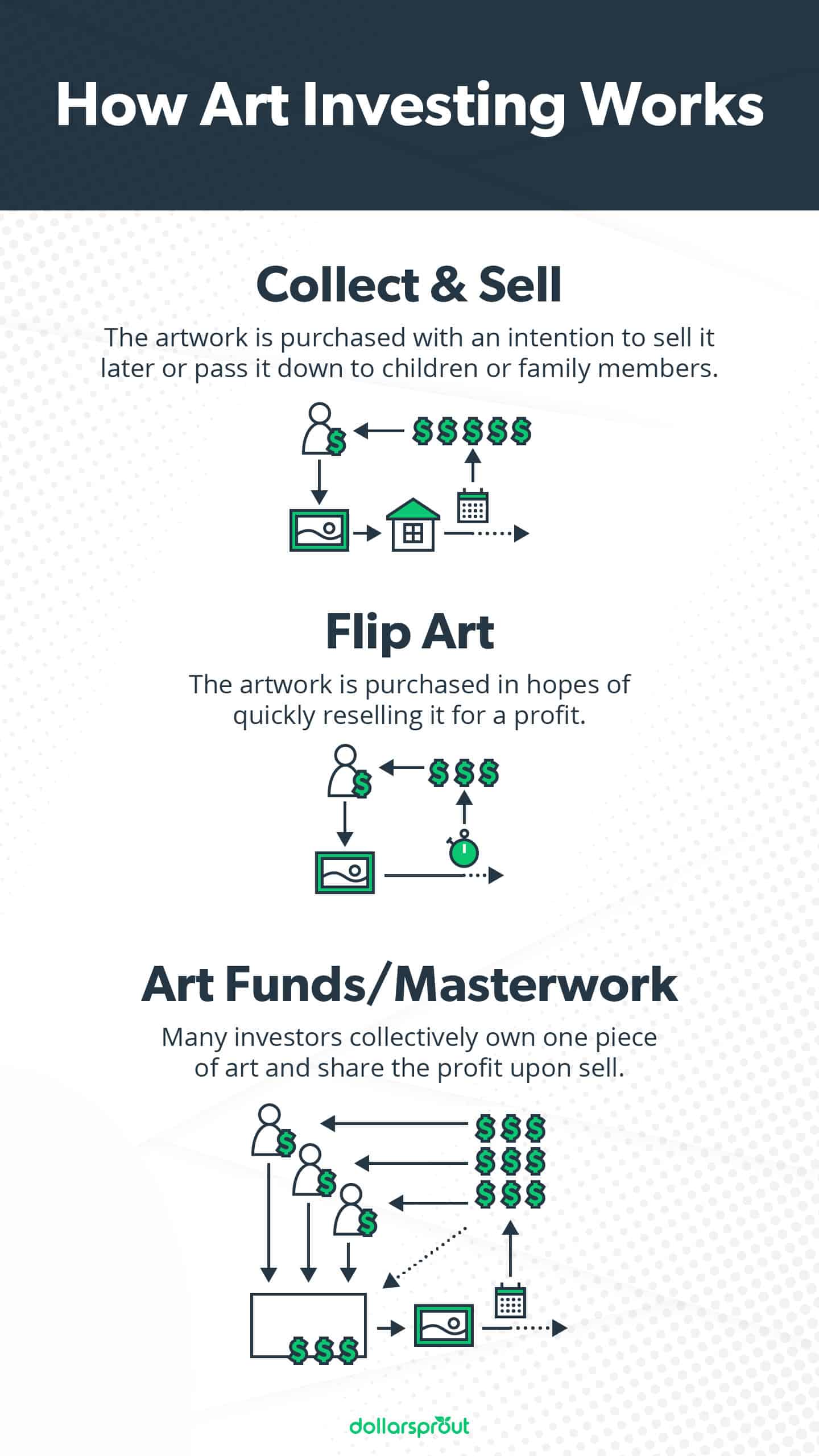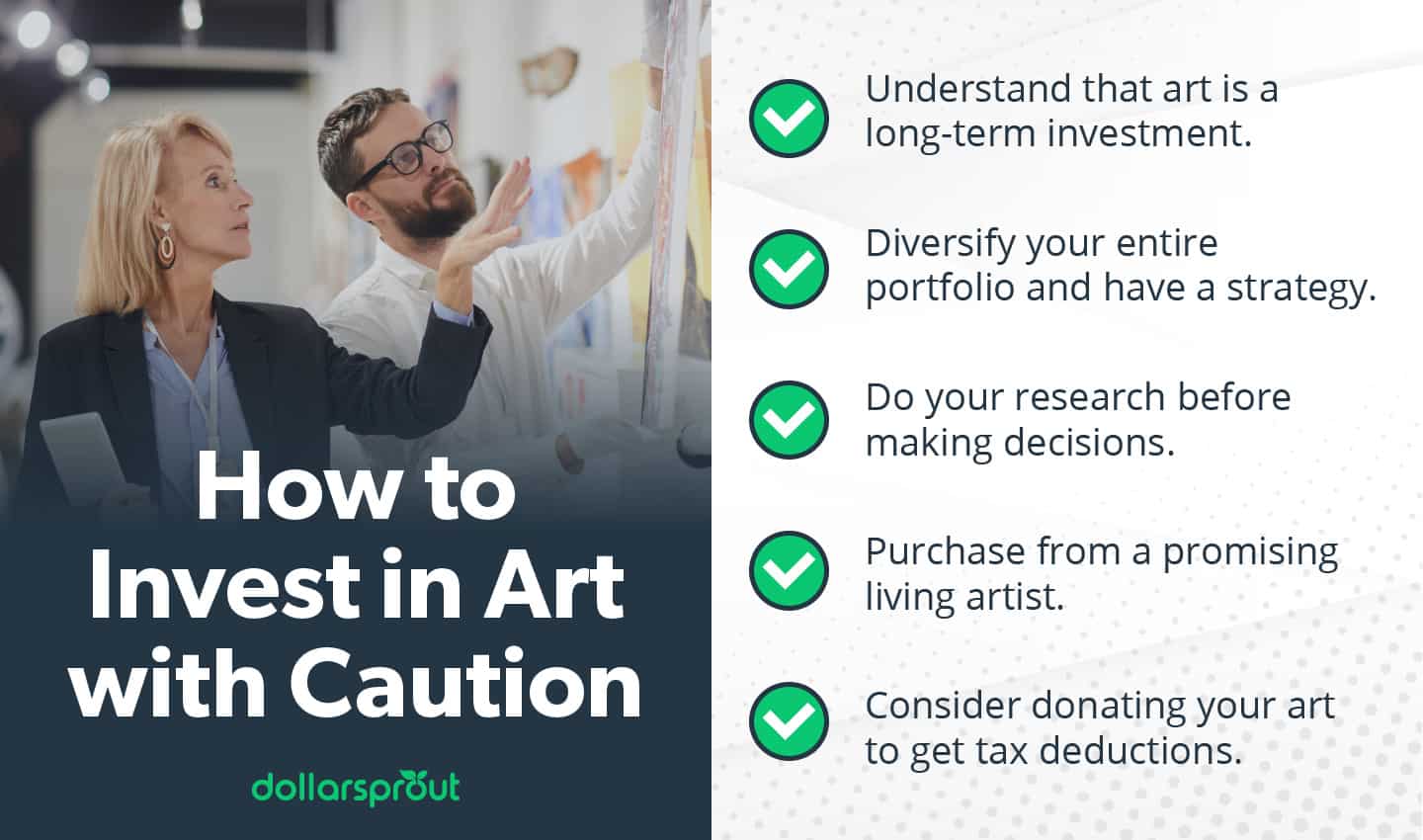4 Easy Ways to Invest in Art (Even as a Beginner)
Fine art investing is best for people who truly enjoy art, but it’s also a good fit if you’re looking for ways to diversify your investment portfolio and balance risk. Here are four ways you can get started.

Some of the links on DollarSprout point to products or services from partners we trust. If you choose to make a purchase through one, we may earn a commission, which supports the ongoing maintenance and improvement of our site at no additional cost to you. Learn more.
If you love art and you’re looking for ways to diversify your investment portfolio, art investing can be a solid choice.
“Not only does [art] appreciate over time, but it’s a strong way to diversify,” said Blair Haden, registrar at Restoration Division, a company that restores art pieces. “If the stock market crashes, fine art can remain unaffected and even continue to rise in value.”
The art market has seen both peaks and valleys, but it consistently returns 7.6% to investors, according to one price index, and outperformed the stock market in 2018. According to a 2024 report by Art Basel and UBS, the art market is now worth $57.5 billion[1].
And there are plenty of ways to capitalize on this lucrative asset. You can purchase artwork, invest in art funds, or even use new services like Masterworks to invest in famous paintings. If you’re looking for an alternative to stocks and other traditional forms of investing, here’s what to know.
What Is Fine Art and Why Are People Investing in It?
Though you may think fine art only includes paintings by famous artists like Picasso or Van Gogh, it’s more than that. Fine art includes just about any creative object made primarily for enjoyment and artistic expression. Fine art also includes several categories beyond paintings and drawings.
Briana Brownell, CEO and founder of Pure Strategy Inc., invests in paintings, sculptures, photography, collectibles, and even fashion pieces. “For me, one of the most compelling things about art investing is you get to live with that piece of art in your life,” she said.
Art has been a popular way to invest for several decades, especially in times of economic uncertainty. For instance, Michael Wenner, vice president of marketing at Masterworks, said that during the coronavirus pandemic, people were looking for alternative investments to the stock market. “People are looking to keep a portion of wealth in something slightly safer that’s asset-backed,” he said.
This type of investing is best for people who truly enjoy art, but it’s also a good fit if you’re looking for ways to diversify your investment portfolio and balance your risk. And because the time horizon on profit is typically measured in years or decades, you should be in it for the long haul, at least 10 years.
4 Ways to Invest in Art
Some investors approach art as purely an investment strategy, while others are lifelong art lovers. Both investor types pursue profits, but some prefer looking at a sculpture instead of a stock certificate, Brownell said. Either way, you have a few options for investing in fine art.
1. Join Masterworks
Masterworks is a service that allows many investors to collectively own one piece of art. Because the minimum buy-in is low, this service has opened the door for retail investors who don’t have millions to spend.
Here’s how it works: Masterworks buys a piece of art, registers it as its own company with the Securities and Exchange Commission, and sells shares to individual investors. The minimum investment depends on your overall investment portfolio. For example, someone with $1 million in various investments would have a higher buy-in than someone starting out with $1,000.
When Masterworks sells the painting, each investor shares the profit or loss. The timeline for earning a profit is between three and seven years, with a target appreciation of 10% to 25%.
One of the benefits is that Masterworks cuts down on the work involved, Haden said. “They have experts in art doing the research behind what they offer, and you can have greater confidence in their estimates and returns.”
Masterworks says it focuses on “blue-chip” art, which is art produced by the top 100 artists whose work is reliably profitable. Blue-chip art has appreciated by 14.1% annually from 1995 to 2021.
“If you were to research a stock or bond, you would want to buy something that has a track record you can analyze,” said Wenner. “That’s why we do artists like Monet and Basquiat and Picasso. You can see how well they’ve done at auction over time and build a quantitative approach.”
But it’s also important to consider the drawbacks. You own just a smaall amount of the painting and have limited control over the investment. You can either wait until Masterworks sells the painting, which takes a few years, or sell your shares on the secondary market to turn a profit. And like most investments, the fee structure will cut into your profit margin.
An annual 1.5% management fee covers storage, transportation, and insurance, and Masterworks will keep 20% of any profit made on an artwork sale.
To date, Masterworks has sold 3 paintings with a net annualized gain of over 30% for each. This isn’t an indication of the overall performance and doesn’t guarantee future results. But it shows investors still can see attractive results despite the fee structure.
Related: What Is Micro Investing and Is It Worth It?
2. Invest in an Art Fund
A mutual fund is similar to Masterworks, where each person in a group owns a little bit of the piece of art. In mid-2014, there were more than 70 art funds operating.
Mutual funds tend to be more exclusive in terms of starting price; minimum buy-in may start anywhere from $2,500 to upward of $1 million. You also pay a management fee of around 1% to 3%, and the fund will keep a percentage of profits made.
But art funds generally come with more control and greater return potential than traditional investing. Art investment fund Anthea said it returned 23.4% between 2013 and 2014, with its best investment earning a 404.3% return. The Fine Art Fund Group says it provided a 9% return before fees.
Aside from the high buy-in, there’s another major downside to this method: You typically don’t get to enjoy the art yourself. But at least one private fund, the Artemundi Global Fund, has found a workaround by allowing investors to take turns displaying the artwork in their homes.
3. Flip Art
Like homes or cars, you can purchase artwork in hopes of quickly reselling the piece for a profit, typically within 5 to 10 years.
Art flipping can be lucrative. In one impressive example, a Jean-Michel Basquiat painting was thrice sold at auction between 2005 and 2012, ultimately fetching $9 million — a 450% price increase.
Many art pieces resell for a higher price, but you’re not guaranteed a profit. Many investors lose money on potentially promising pieces. For example, paintings by Lucien Smith sold for around $390,000 in 2013. But prices on his work dropped to around $5,000 to $20,000 in later years.
The art community frowns on the practice of art flipping. It can result in artificial price spikes, which especially hurts young, up-and-coming artists. Additionally, when a piece of art enters the secondary market, the original artist usually doesn’t see any profit from sales.
4. Collect and Sell Art
When you buy artwork, you may choose to sell the pieces later on or pass them down to your children and other family members.
If you decide to sell, your earnings could fall in line with the 7.6% average return. A good place to sell is through a fine art auction house. However, they typically take around 5% to 25% of your sale price.
Before you buy a piece of art, whether it’s at an art gallery, art fair, or online, you can take some precautions to ensure a good investment. Haden recommends researching the artist, the art piece, and the art dealer. Once you own the art piece, take care of it to preserve the value and consider having it insured.
You also might need to invest in a restoration, which “revitalizes artwork, increases its longevity, stops degradation, and can increase the final sale price,” Haden said.
When you’re looking to sell the art, Haden advises to get an appraisal, verify the artist’s signature, and check open auction sale prices. Once you know the market value for an artist and any sales fees involved, you can plan how best to sell the piece.
Related: A Beginner’s Guide to Investing in the Stock Market
How to Invest in Art with Caution
Before investing in fine art, you should first make sure you’ve contributed enough to your other investment accounts, including retirement. Most people dedicate only a portion of their investment portfolio to art because it may not provide enough profits for a steady income.
You should also think about the types of art you want to invest in and how much you want to spend upfront.
“I started with making my own purchases and choosing pieces that were important to me or that I really liked,” said Brownell, who tracks the value of her collection about every five years. “I have pieces that I paid less than $1,000 for. They’ve increased a lot since then. But if you’re savvy enough, you can get in at the lower amount.”
Here are a few expert tips in turning a profit through art investing:
- Diversify your portfolio. Make sure art is only a small part of your portfolio. A financial adviser should help you develop an investment strategy.
- Be realistic. Art investing isn’t a get-rich-quick method. Rather, it’s a long-term investment.
- Do your research. You should regularly track artists, their artwork, and sales prices, and try to make objective decisions. For example, Haden advises that before investing in pieces from last year’s hottest artist, check how their art is selling now.
- Purchase from a living artist. Great artists who are deceased, like Picasso, have well-established reputations with prices to match. But if you find work by a young artist who shows promise, the work might start at a lower price point and increase over time, Brownell says.
- Consider donating your art. You may be able to get a tax deduction for donating pieces from your collection. Brownwell said, “In that case, the investment is about being able to offset some of your tax burden.”
Keeping this advice in mind can guide your art purchases, especially for people new to this type of investment.
Is It Risky to Invest in Fine Art?
Most investing comes with some form of risk, and art is no exception. The art market contracts periodically, just like stocks and bonds. It’s also hard to determine the true value of artwork because it partially depends on the artist’s reputation and the overall economy.
Additionally, art is non-liquid, meaning it’s difficult to quickly convert your investment to cash. If you want to sell it, you’ll need to get the artwork appraised, find an auction house willing to take on the sale, and hope someone buys the piece.
“You may end up having a lot of your money tied up in assets where it’s difficult to sell them when you want to,” Brownell says.
And like any physical asset, there’s always the risk of artwork being destroyed in an accident or depreciated through wear and tear.
For these reasons, it’s important to do your research, figure out how much you can invest, and discuss with an adviser before investing in this asset class. It can be a great path to enjoying your portfolio in a new way.
Related: How This Artist Earns $5K+ a Month Licensing Her Artwork










